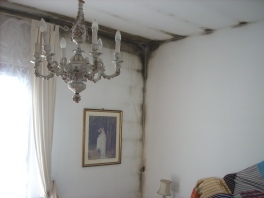
Example of mold – photo by Damiano Chiarini.
Mold and condensation on the interior surfaces of a house’s thermal envelope is a self-evident proof of poor quality and lack of health and comfort for the building occupants. It can happen on walls, roof, slabs and so on.
These phenomena are symptoms of degrading building quality, and have immediate direct consequences on indoor air quality, health of the occupants and the overall comfort inside the house.
surface condensation
Surface condensation is liquid water that forms on the inner surfaces of the house in particularly cold spots. It occurs where the localized temperature is low enough to reach the dew point, causing the water vapor in the air to condensate. In other words, water drops start showing up on the inner surfaces of windows, walls etc..
A classic example of where this phenomenon occurs most frequently is in old-school, single-pane windows, or low quality, double-pane windows with aluminum spacers that keep the two glass panes separate. Where this happens, it deteriorates the structure, the finishes, the openings and more.
mold
The appearance of mold is a similar phenomenon to surface condensation, but it is different enough to be treated separately. Mold may appear in the weaker spots of the thermal envelope, even without surface condensation (the structure it appears on may still be dry), when the humidity level of the air remains high for several days.
You can buy off-the-shelf anti-mold paint, however this can be harmful for human health, and they do not solve the problem: even if you apply several layers of anti-mold paint, sooner or later the problem is going to come back again.

Mold caused by a thermal bridge and lack of ventilation – photo by Damiano Chiarini
how to eliminate mold and condensation problems
Both phenomena described above – surface condensation and mold -are caused by two main factors: thermal bridges and high humidity level of indoor air. To solve them once and for all, you first need to work on the thermal envelope of the building, fixing all thermal bridges so as to obtain an even interior temperature on all surfaces and increase the level of comfort. Secondly, you need to consistently remove humidity from the indoor air: even the best Passive House in the world is going to have mold problems if you don’t remove the water vapor that you produce on a daily basis by simply living in it.
House ventilation can be just manual (“I physically open the windows”), or integrated with a mechanical ventilation system. In Italy, this topic is particularly controversial, and we are going to write extensively about it in our future articles. However, we want to underline how thermal bridges are caused by poor design and construction, but lack of ventilation is caused by poor building use and misunderstandings by the occupants who live or work in the building.
Meaning that when there is mold and condensation, the fault often lays with the users or occupants, as they are in control of the level of ventilation. Unfortunately in Italy, less than 1% of residential buildings are equipped with mechanical ventilation (source: ISTAT via TABULA).
Solving (or preventing) mold and condensation is one of the fundamental aspects of a deep energy retrofit, that can guarantee indoor comfort, not only energy savings. Anybody can tell you to add insulation, or to replace your windows. A deep energy retrofit has to be conceived as a whole, with technical analyses that can avoid the problems that we described in this article.
other humidity problems
Other topics related to humidity include ground moisture control and condensation within structure: neither of these play a major role for mold or surface condensation, as described in the present article.

[…] Read more… […]